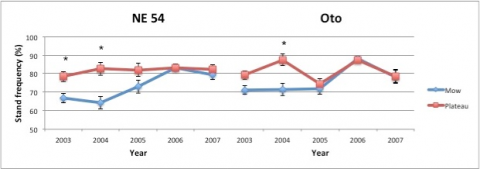Can a Rye Cover Crop Reduce Wind Erosion from Fields with Little Residue Cover?
February 12, 2018
Researchers examined the effect of a rye cover crop on reducing soil erosion from wind in fields where a large amount of the crop residue had been removed.
Can Manure Improve Soil Health or Soil Quality?
February 8, 2018
Is land application of manure something you're considering or practicing? Two university research articles look at potential effects on soil health and soil quality.
Switchgrass Barriers as a Soil Water Conservation Practice
February 7, 2018
Research was conducted to compare infiltration rates in switchgrass barriers and a soybean field. Results showed the value of grass barriers in improving soil structure and infiltration and reducing runoff of sediments and nutrients.
Does Weed Control Method Impact Indiangrass Establishment and Persistence?
February 5, 2018
This study evaluated two weed control methods and seeding rates on establishment and persistence of two indiangrass cultivars, ‘Oto’ and ‘NE 54’, from 2003 to 2007.
Does Seeding Rate Affect Establishment-Year Growth and Long-term Forage Yield of Indiangrass?
February 5, 2018
Recent improvements in forage yield and nutritive value of indiangrass, along with its wide range of adaptation should increase its use in bioenergy and forage production, conservation practices, and reclamation projects in the central Great Plains. This study tested five seeding rates with two varieties — 'Oto' and 'NE 54' — and the effects on dry matter production
Growers Statewide to Share On-Farm Research Results
January 26, 2018
Farm operators and agronomists from across the state are invited to hear about results from over 80 on-farm research projects at the Nebraska On-Farm Research Network update meetings this February. Projects cover products, practices, and new technologies that impact farm productivity and profitability.
Could Sub-Saharan Africa be the World's Next Breadbasket? Nebraska Study Says It's Unlikely
November 17, 2017
While there is huge potential for sub-Saharan Africa to increase agricultural productivity, the odds that the region will become the world's next breadbasket are low, according to a new study from the University of Nebraska-Lincoln. While the area receives more rain than the world's other breadbaskets, its shallower and "older" soils may not serve as good water reservoirs during periods of little rainfall.
University Studies Sugarbeets as a Livestock Feed for Weaned Calves
November 17, 2017
In the third year of its research on using chopped sugarbeets for livestock feed, university researchers are moving from using pregnant cows to weaned calves as their research subjects. Growing and finishing trials will be conducted with calves both receiving and not receiving sugarbeets as an energy source.







